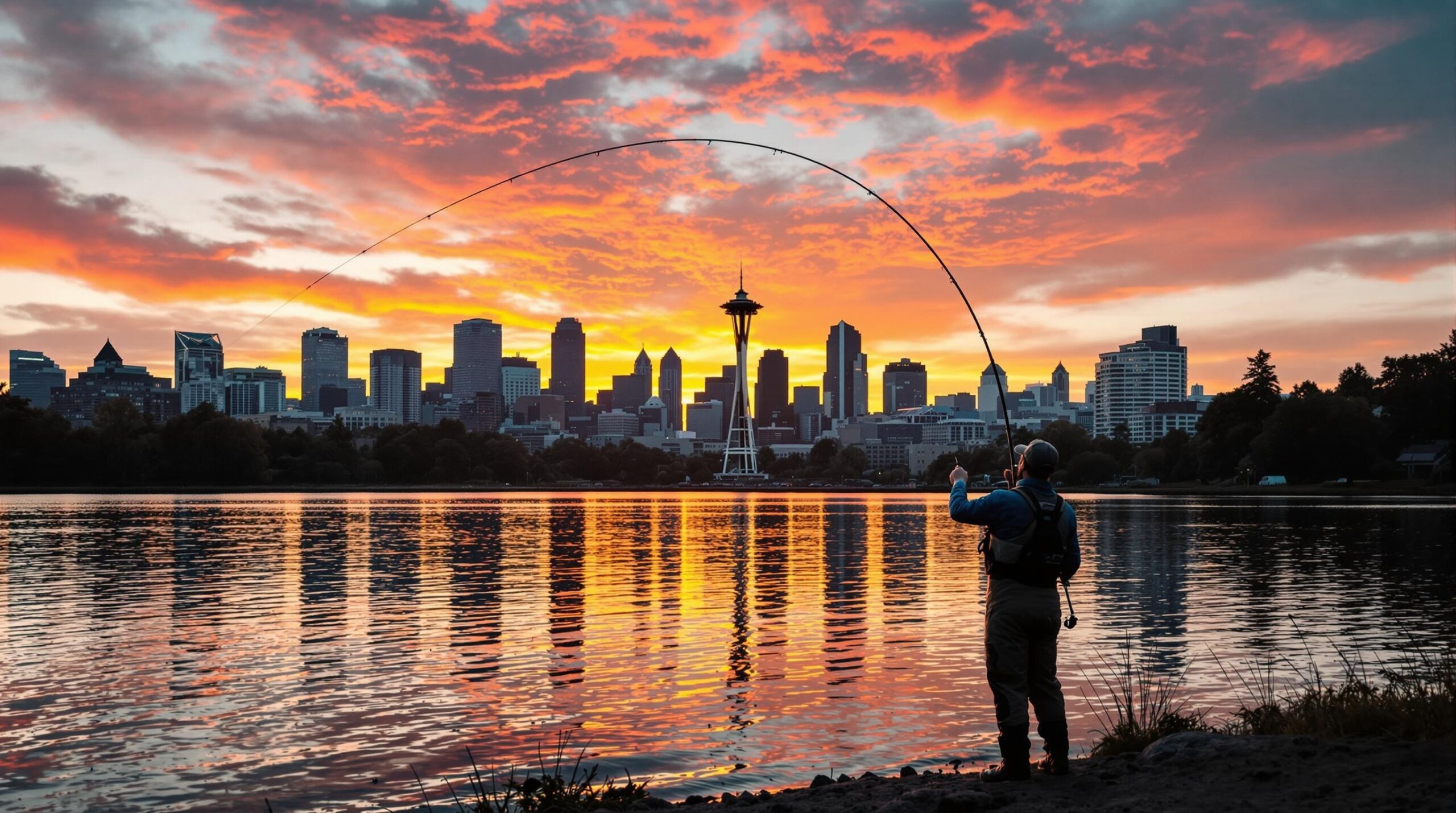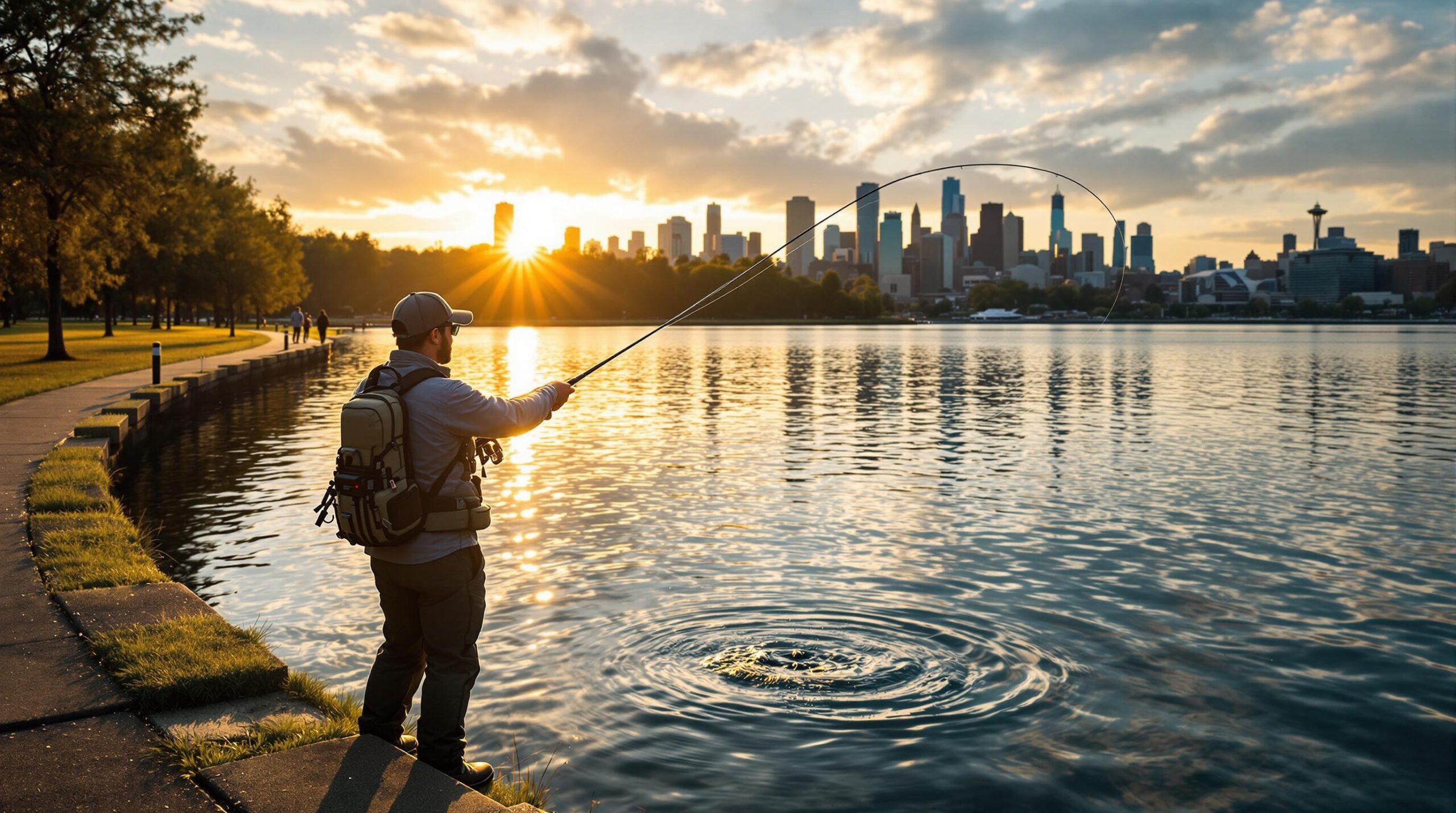According to the Washington Department of Fish and Wildlife, Seattle’s urban waterways host over 15 different fish species within city limits, making urban fishing one of the most accessible angling opportunities in the Pacific Northwest. From trout-filled lakes to salmon runs threading through downtown neighborhoods, this city offers exceptional fishing experiences just minutes from metropolitan areas. With abundant shore access and stocked waters, Seattle urban fishing provides a rare blend of convenience and quality, allowing anglers to cast a line without ever leaving the city.
Key Takeaways
- Seattle offers year-round fishing opportunities across more than 20 accessible locations within city limits
- Green Lake and Lake Washington provide prime trout fishing with easy shore access and parking
- The Ship Canal system connects multiple fishing spots from Ballard Locks to Lake Union
- Seasonal salmon runs bring coho and chinook salmon directly through urban waterways from July through October
- Most Seattle fishing locations require only a Washington State fishing license with no additional permits
Prime Seattle Urban Fishing Locations
Green Lake stands as Seattle’s crown jewel for urban angling. This 259-acre lake maintains a consistent trout population through regular stocking programs by the Washington Department of Fish and Wildlife. The lake receives monthly trout plants from March through October, with rainbow trout averaging 10-14 inches providing steady action for both fly and conventional anglers.
Lake Washington offers more challenging but rewarding opportunities. This massive lake supports native cutthroat trout, smallmouth bass, and seasonal salmon runs. At over 22,000 acres with depths exceeding 200 feet, Lake Washington creates diverse fishing environments across various depth zones.
Seasonal Fishing Patterns
Spring fishing peaks from April through June when water temperatures climb into the optimal 50-60 degree range. Seward Park’s shoreline becomes particularly productive during this period, offering excellent access and consistent trout action.
Summer brings salmon migrations through the Ship Canal system. Urban fly fishing locations like the Ballard Locks fish ladder attract thousands of returning coho and chinook salmon from July through September.
Fall extends the fishing season through November with continued salmon activity and active trout feeding before winter. Lake Union’s northern shores produce consistent results during these months, particularly during overcast conditions.
Essential Gear for Urban Fishing Success
Light to medium-action rods between 6-8 feet handle the majority of Seattle’s urban fishing scenarios. Spinning reels spooled with 8-12 pound test line provide adequate strength for urban species while maintaining sensitivity for detecting subtle bites.
Fly fishing enthusiasts should consider 5-6 weight rods matched with floating lines. The urban environment demands versatility over specialization, as you may encounter everything from 8-inch planted trout to 15-pound salmon on the same day.
Bait and Lure Selection
PowerBait and salmon eggs consistently produce results at stocked trout locations like Green Lake. Bright colors like chartreuse and orange perform best in urban water conditions where visibility may be reduced.
Small spinners and spoons ranging from 1/8 to 1/4 ounce cover active feeding periods effectively. Rooster Tail spinners in rainbow and brook trout patterns prove especially effective during morning and evening feeding windows.
Fly patterns should include standard nymphs, small streamers, and emerging insect imitations. Chironomid patterns work particularly well in Seattle’s urban lakes, especially during spring and fall transitions.
Regulations and Licensing Requirements
All Seattle urban fishing requires a valid Washington State fishing license for anglers 15 years and older. Annual licenses cost $34.90 for residents and $66.65 for non-residents as of 2024, though prices may change annually.
Daily bag limits vary by location and species. Green Lake maintains a 5-trout daily limit with no size restrictions on planted fish. Lake Washington follows standard statewide regulations with specific salmon seasons and size limits that change based on conservation needs.
Special Urban Water Rules
Several Seattle fishing locations implement barbless hook requirements to reduce fish mortality, particularly in waters with wild fish populations. Night fishing restrictions apply to many urban parks for safety and noise considerations, with most locations closed to fishing from sunset to sunrise.
Parking fees and time limits affect some prime fishing spots. Seward Park charges $1 per hour with a 4-hour maximum during peak season. Plan accordingly and bring exact change or use mobile payment options where available.
Understanding Seattle’s Urban Fishery Ecosystem
Seattle’s fishing opportunities exist within a complex ecosystem shaped by both natural geography and human engineering. The Ship Canal system artificially connects Puget Sound with Lake Washington through a series of locks and engineered channels, allowing anadromous fish species to migrate through urban areas.
Urban runoff affects water quality and fish behavior in predictable ways. Stormwater introduces nutrients and temperature fluctuations that influence feeding patterns and fish distribution throughout the year. Understanding these patterns helps predict the best fishing times and locations.
Water Quality and Fish Health
Seattle’s urban waters undergo regular monitoring by the King County Department of Natural Resources. Monthly water quality reports track temperature, dissolved oxygen, and pollutant levels across major fishing areas.
Fish consumption advisories apply to certain urban waters due to industrial legacy contamination. Lake Washington carries restrictions on bottom-feeding fish consumption, while surface species like trout and salmon remain generally safe for consumption in moderate quantities.
Advanced Techniques for Urban Success
Urban fishing environments demand adapted techniques that account for increased fishing pressure and altered fish behavior. Fish in heavily fished waters become more selective and cautious than their wilderness counterparts.
Stealth and presentation become critical factors. Light line, small lures, and natural presentations outperform heavy tackle and aggressive retrieves in most scenarios. Fly fishing techniques in Washington require reading water conditions and adapting approaches accordingly.
Seasonal Migration Patterns
Salmon migrations through Seattle’s urban waterways follow predictable seasonal patterns influenced by ocean conditions and spawning cycles. Coho salmon typically arrive in urban waters from July through September, while chinook salmon appear from May through August.
Trout movements within urban lakes respond to temperature stratification and food availability. During summer months, trout often move to deeper, cooler waters during midday periods, making early morning and evening fishing most productive.
Best Times for Fishing Success
Early morning hours from dawn until 9 AM consistently produce the highest catch rates across all Seattle urban fishing venues. Fish remain most active during these cooler periods when human activity is minimal.
Evening feeding windows occur from 6 PM until dark, especially during summer months. Insect activity increases during these times, triggering aggressive fish behavior and creating excellent surface action opportunities.
Overcast days with light precipitation often improve fishing conditions in urban environments. The reduced light levels encourage fish to feed more actively throughout the day, rather than retreating to deeper waters.
Conservation and Ethics
Urban fishing environments require heightened conservation awareness due to increased pressure and limited habitat. Every angler’s actions directly impact the sustainability of these accessible fisheries.
Leave No Trace principles apply especially to urban fishing areas where litter and damage become highly visible. Proper disposal of fishing line prevents wildlife entanglement and maintains area aesthetics for all users.
Selective harvest practices help maintain fish populations for future generations. Consider keeping smaller, planted fish while releasing larger, potentially wild fish to support long-term fishery health.
Supporting Enhancement Programs
Volunteer programs through the Washington Department of Fish and Wildlife provide opportunities to participate in habitat restoration and fish stocking programs. These initiatives directly benefit Seattle’s urban fishing opportunities.
License fees and taxes on fishing equipment fund ongoing urban fishery management programs. Beginning anglers can start their journey in these well-maintained urban environments that benefit from dedicated funding.
Planning Your Urban Fishing Adventure
Successful urban fishing adventures require careful planning that considers location access, parking availability, and seasonal conditions. Urban fishing differs significantly from remote angling in logistical requirements.
Transportation and parking present unique challenges. Many prime locations offer limited parking or require payment during peak hours. Arrive early during weekends and holidays to secure parking and prime fishing spots.
Weather conditions affect urban fishing more dramatically than wilderness angling due to increased runoff and temperature fluctuations. Check weather forecasts to predict optimal fishing conditions and plan accordingly.
Frequently Asked Questions
What fish species can I catch in Seattle’s urban waters?
Seattle’s urban waters offer rainbow trout, cutthroat trout, smallmouth bass, coho salmon, chinook salmon, and various panfish species across different waterways throughout the year.
Do I need a special license for Seattle urban fishing?
You need a standard Washington State fishing license for all Seattle urban fishing. No additional permits are required for most locations, but check specific regulations for each water body before fishing.
What’s the best time of year for Seattle urban fishing?
Spring through fall offers the best fishing, with April through June peak for trout and July through October optimal for salmon runs through urban waterways and canal systems.
Can I fish from shore at most Seattle urban fishing spots?
Yes, most Seattle urban fishing locations provide excellent shore access with designated fishing areas, parking, and facilities designed specifically for bank fishing rather than boat access.
Are there size and bag limits for Seattle urban fishing?
Size and bag limits vary by location and species. Green Lake allows 5 trout daily with no size limit, while Lake Washington follows standard state regulations with seasonal variations for salmon.
What gear should I bring for successful urban fishing?
Bring light to medium spinning gear, 8-12 lb line, small lures or bait, a net, pliers, and a tackle box. Urban fishing requires versatile, portable equipment for various species and conditions.
Sources:
Washington Department of Fish and Wildlife – Urban Fisheries Management Report: King County Waters
Washington State Recreation and Conservation Office – Urban Fishing Participation Trends
University of Washington Fish Ecology Lab – Lake Washington Native Fish Recovery Study
Puget Sound Anglers – Seasonal Success Rate Analysis
King County Parks Department – Urban Fishing Access Infrastructure Report
Washington State Tourism Office – Urban Fishing Economic Impact Assessment
Wild Fish Conservancy – Population Monitoring Data
WDFW – Hatchery Program Annual Stocking Reports


